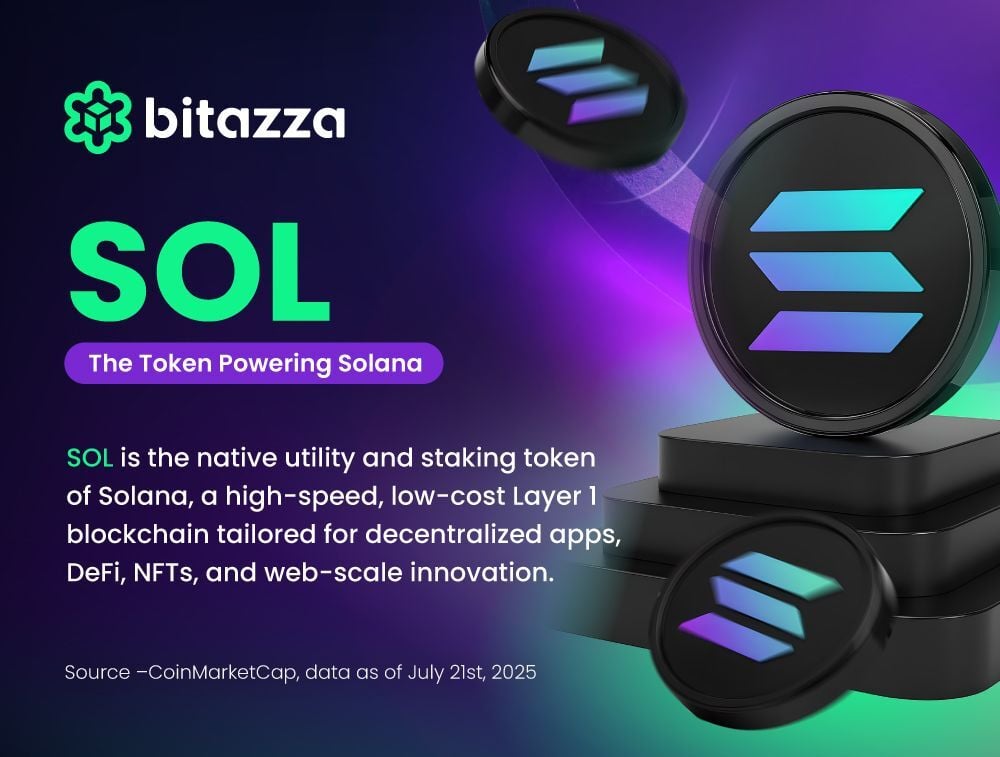Share this
What is SOL? The Token Powering Solana’s Lightning-Fast Blockchain

SOL is the native utility and staking token of Solana, a high-performance Layer 1 blockchain designed for speed, scalability, and affordability. Built to support decentralized apps (dApps), NFTs, and DeFi protocols, Solana combines a unique Proof-of-History (PoH) mechanism with Proof-of-Stake (PoS) to achieve industry-leading throughput and sub-second finality.
Launched in 2020 by the Solana Foundation, the project has become a serious contender to Ethereum, offering low-cost, high-speed infrastructure for developers and users around the world.
What Does SOL Do?
SOL is the backbone of the Solana ecosystem. Whether you’re sending a transaction, minting an NFT, or staking to secure the network, SOL is what makes it all happen.
With SOL, you can:
- Pay transaction fees: Solana’s average transaction cost is just $0.00025.
- Stake and earn rewards: Validators and delegators secure the network and earn SOL.
- Participate in governance: SOL holders have influence over protocol decisions as Solana expands governance capabilities.
- Use across dApps: SOL powers countless Solana-based platforms in DeFi, NFTs, gaming, and more.
Why Is SOL a Big Deal?
Solana is more than just fast, it’s one of the few blockchains that scales without sacrificing decentralization or affordability. That combination has helped it become a go-to platform for developers, creators, and investors alike.
Here’s why SOL stands out:
- Processes thousands of transactions per second (TPS)
- Finality in under 400 milliseconds
- Low, predictable gas fees, even at scale
- Home to major NFT collections, DeFi protocols, and Web3 games
- Backed by a vibrant developer ecosystem and global community
SOL Supply Snapshot
As of July 17, 2025 (source: CoinMarketCap):
- Total Supply: ~576 million SOL
- Circulating Supply: ~447 million SOL
- Max Supply: No hard cap. Inflation begins around 8% and gradually decreases to 1.5% annually
Solana uses a disinflationary model, where a portion of transaction fees are burned to offset inflation over time. This balances supply growth with network incentives.
How Does Solana Work?
Solana’s architecture is unique. It combines:
- Proof-of-History (PoH): A cryptographic clock that timestamps transactions before consensus.
- Proof-of-Stake (PoS): Used to validate blocks and secure the network.
This hybrid model enables ultra-fast block times and low costs without centralized bottlenecks. Each validator runs the same clock, which reduces confirmation time and improves throughput.
It’s also why Solana has become a favorite for projects in high-volume use cases like trading, gaming, and NFTs.
Where Can You Trade SOL?
SOL is one of the most widely available tokens across centralized and decentralized exchanges. You can easily buy, sell, and trade SOL directly on the Bitazza app alongside 100+ other tokens.
What Are the Risks?
Like any crypto asset, SOL has its considerations:
- Network outages: Solana has experienced downtime events that affected uptime and usability.
- Validator centralization: The hardware demands of running a node may limit decentralization.
- Price volatility: SOL’s market price can swing sharply with macro and crypto trends.
- Ecosystem competition: Competing Layer 1s and L2s are rapidly innovating.
Final Thoughts
SOL isn’t just a utility token, it’s the heartbeat of one of crypto’s fastest-growing ecosystems. With blazing-fast speeds, low costs, and an ever-expanding universe of apps and users, Solana continues to push the boundaries of what’s possible on-chain.
Whether you’re a trader, creator, or builder, SOL puts the full power of web3 in your hands. Buy and trade SOL and 100+ other tokens right from your phone.
Share this
- Crypto 101 (75)
- Trading (60)
- Crypto Weekly (46)
- Educational (43)
- Bitazza 101 (41)
- Featured (11)
- Missions (8)
- Market (6)
- Bitazza Insight (5)
- Research (5)
- Derivatives (4)
- TradingView (4)
- Education (3)
- Futures Trading (3)
- Freedom Shards (1)
- Freedom Token (FDM) (1)
- Intermediate (1)
- Product and features (1)
- Tether (1)
- Tether (USDt) (1)
- crypto exchange (1)
- December 2025 (3)
- November 2025 (6)
- October 2025 (10)
- September 2025 (8)
- August 2025 (17)
- July 2025 (29)
- June 2025 (13)
- May 2025 (14)
- April 2025 (12)
- March 2025 (8)
- February 2025 (8)
- January 2025 (8)
- December 2024 (7)
- November 2024 (5)
- October 2024 (14)
- September 2024 (9)
- August 2024 (14)
- July 2024 (3)
- June 2024 (48)
No Comments Yet
Let us know what you think